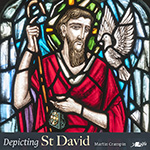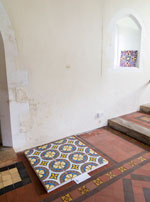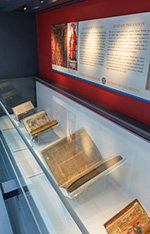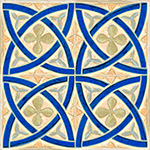
For more recent news on work relating to stained glass see also the Stained Glass from Welsh Churches blog
News and events archive
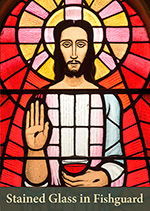 Saints and Stained Glass for the Ports, Past and Present project
Saints and Stained Glass for the Ports, Past and Present project
In the closing months of the Ports, Past and Present project I published books on stained glass in two of the port towns that were the focus of the project.
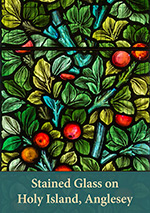 Stained Glass in Fishguard was produced in association with St Mary’s in Fishguard and includes stained glass from churches in the town, a panel in the town library, and stained glass from churches in Goodwick and Manorowen. Copies are available from the church or from Sulien Books.
Stained Glass in Fishguard was produced in association with St Mary’s in Fishguard and includes stained glass from churches in the town, a panel in the town library, and stained glass from churches in Goodwick and Manorowen. Copies are available from the church or from Sulien Books.
A second book included stained glass from churches in Holyhead and from othr churches on Holy Island. It was launched with a walking tour of the windows on 1 July 2023, beginning at the Maritime Museum where two windows from St Seiriol’s, demolished in the 1990s, are now on display. More about these books can be found on the Stained Glass from Welsh Churches blog.
A series of short illustrated articles relating to stained glass and journeys of the saints across the Irish Sea are found were prepared for the project, making use of these stories to develop tourist narratives.
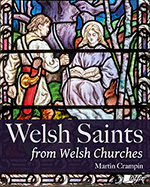 Welsh Saints from Welsh Churches
Welsh Saints from Welsh Churches
Welsh Saints from Welsh Churches was my first major book since Stained Glass from Welsh Churches was published in 2014. It illustrates the imagery of Welsh saints found in churches in Wales from the medieval period and up to the present day, revealing a wealth of imagery since the mid-nineteenth century that has not been studied before.
The book is illustrated in full colour throughout and takes a journey around Wales to cathedrals and churches large and small in city centres, quiet suburbs, towns, villages and lonely fields. Some are now closed, but at a time when communities are working hard to ensure that their churches remain open for worship and for visitors, the book is a timely reminder of the artistic treasures that can be found in places of worship in Wales.
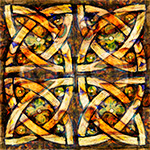 Esgyrn Cybi/The Bones of St Cybi
Esgyrn Cybi/The Bones of St Cybi
The last exhibition of work from the Ports Past and Present project for 2022 took place at Ucheldre Arts Centre in Holyhead, which opened in October 2022. I had hoped to complete some of my own work for the previous exhibitions, but finally made some new images for our show in Holyhead.
The images were inspired by the seizure of the shrine of St Cybi at Holyhead, which was taken to Dublin in the fifteenth century. My images overlay what little survives of the medieval ornament at Christ Church Cathedral in Dublin – the patterns on some of the medieval tiles – with the late medieval stone carving from the south side of the church at Holyhead, which is still dedicated to Cybi.
The pictures subsequently made their own journey to Ireland, and were shown in an additional Ports, Past and Present exhibition in Wexford in February–March 2023.
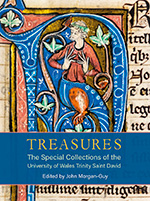 Treasures/Trysorau
Treasures/Trysorau
Treasures: The Special Collections of the University of Wales Trinity Saint David introduces the extraordinary collection of rare books and manuscripts held in the special collections of the university at Lampeter, many of which were given by the founders of St David’s College in the nineteenth century. The book was written by various contributors and edited by John Morgan-Guy, who I worked with on the Visual Culture of Wales and Imaging the Bible in Wales projects from 1999 until 2008.
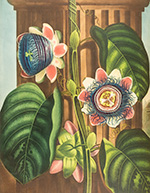
I photographed a selection of pages and images from each of these ‘treasures’ and designed the book which was published in separate Welsh and English volumes. The ‘treasures’ included medieval illuminated manuscripts, early printed books, and lavishly illustrated ethnographic, zoological, botanical and architectural volumes. Trysorau: Casgliadau Arbennig Prifysgol Cymru Y Drindod Dewi Sant was launched at the National Eisteddfod in Ceredigion in August 2022, alongside the English volume and was published by the University of Wales Press.
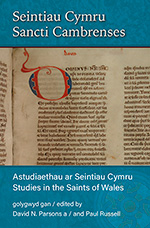 Chapters in Seintiau Cymru, Sancti Cambrensis
Chapters in Seintiau Cymru, Sancti Cambrensis
Two of my articles appeared in the new volume Seintiau Cymru, Sancti Cambrensis: Astudiaethau ar Seintiau Cymru, Studies in the Saints of Wales. The book was edited by David Parsons and Paul Russell and completed in time for a launch in 2022 at the Welsh Manuscripts Conference at the National Library of Wales. It was published by the Centre for Advanced Welsh and Celtic Studies.
One article is a study of the imagery of St David, while the other considers the surviving medieval imagery of saints in Wales. There is also an appended list of images of saints that survive in Wales. Both of these contributions are illustrated with colour images. The book was typeset and designed by David Parsons, although I assisted with design of the cover.
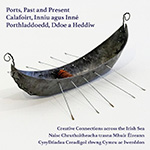 Ports, Past and Present exhibitions
Ports, Past and Present exhibitions
A series of exhibitions and events for the Ports, Past and Present project were held throughout 2022. The exhibition of work consisted of contributions created by twelve creative practitioners for the project, including film, animation, sculpture, mimeograph postcards, photography and illustration. Further work by writers was included on a series of panels, which I designed along with an anthology (left) of the work that was launched at the exhibition. I co-curated the show with Mary-Ann Constantine and Elizabeth Edwards and we subsequently took it – in different iterations – to Rosslare, Pembroke Dock, Dublin, Fishguard and Holyhead in 2022, and to Wexford in 2023.
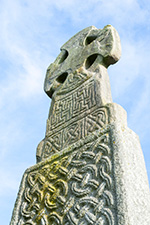 Teaching Celtic Art
Teaching Celtic Art
In spring 2022 I prepared and taught a module for the Celtic Studies (BA) distance-learning course at the University of Wales Trinity Saint David. An ‘Introduction to Celtic Art’ begins in pre-history, looking at Iron Age metalwork from across western and central Europe before looking more closely at late Iron Age, Romano-Celtic and early medieval decoration and ornament in Britain and Ireland. The course also looks at the impact of forms familiar to us as ‘Celtic Art’ on more recent artists and designers across a range of visual culture.
The recorded lectures for the module made use of my extensive photographic archive visiting historic sites and museums over the last twenty-five years, including scanning old photographic prints and slides. Preparing the talks also reminded me of some of the imagery that I was making in the 1990s that was inspired by some of these examples of visual culture, when making installations and animation based on early Welsh prose narratives.
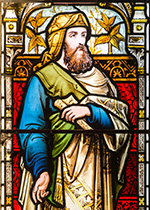 Stained glass by Ward & Hughes at Swalcliffe, Oxfordshire
Stained glass by Ward & Hughes at Swalcliffe, Oxfordshire
The conservation of stained glass is often a pressing problem for historic buildings, especially in the case of the considerable number of mid-nineteenth century windows that have suffered from paint loss, fungal growth and bowing and cracking from a combination of the ways in which the windows were manufactured and installed and ongoing environmental factors.
In the autumn of 2020 I was approached to write a detailed illustrated statement of significance for the church at Swalcliffe in Oxfordshire, setting out the history and national context for a series of windows by Ward & Nixon/Ward & Hughes. Preparation of the report was a reminder of how little has been written about the work of the firm, who were tremendously prolific from the 1850s and into the early twentieth century, in their various incarnations.
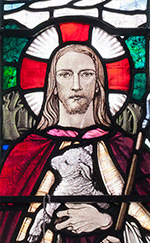 New work consolidating windows catalogued on Stained Glass in Wales
New work consolidating windows catalogued on Stained Glass in Wales
Over the course of 2020 I revisited and updated hundreds of records on the database shared by the Stained Glass in Wales and Imaging the Bible in Wales websites with the help of funding provided by the Glaziers Trust.
This included improving the dating of windows already online, and attributing dozens of windows using archival information as well as evidence presented in recent publications. I also used information from these sources to update notes on over 80 artists and studios, and listed 120 new articles and books in the bibliography, adding hundreds of references from these publications to artists, studios and windows on the site. With so much of this work completed, it will be easier to keep the database updated with information from new publications where possible.
Further windows were added to the site, including important collections of stained glass at Leighton (big windows of the 1850s by Forrest & Bromley), Ely (Cardiff, windows by Francis Spear and Veronica Whall), Betws (near Ammanford, a fine set of modern windows with Lawrence Lee’s wonderful east window), Pontyberem (more modern windows including work by John Petts and Gareth Morgan) and over 300 new images have been added, such as numerous details from St Mary’s Abergavenny, and the addition of Helen Whittaker’s recent Tree of Jesse at the church. Much remains to be done, and more information can be found on the Stained Glass from Welsh Churches blog.
My first book published by Y Lolfa since Stained Glass from Welsh Churches was published in February 2020, and was launched at a small event at Cardiff Cathedral on 16 March. The book, Depicting St David, is a study of the imagery of Wales' patron saint, and shows different ways in which the saint has been depicted, both as a standing figure alone or with others, and in scenes depicting stories associated with the saint. I have written more about the book and a few of the discoveries made along the way on my blog. For copies visit Y Lolfa website.
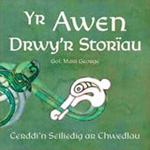 A very different book published by Barddas in March 2020 featured my illustrations in a book of Welsh poetry. The book, edited by Mari George and elegantly designed by Tanwen Haf, includes poems and prose texts inspired by medieval Welsh narratives. The modern poetry, based on these old traditions, is mirrored by my own work, which adopts forms found in eleventh-century manuscript illumination, layered with later medieval patterns. Llawer o ddiolch i Alaw Mai Edwards, a former colleague on the 'Cult of Saints in Wales' project, for her intiative in bringing this project to fruition.
A very different book published by Barddas in March 2020 featured my illustrations in a book of Welsh poetry. The book, edited by Mari George and elegantly designed by Tanwen Haf, includes poems and prose texts inspired by medieval Welsh narratives. The modern poetry, based on these old traditions, is mirrored by my own work, which adopts forms found in eleventh-century manuscript illumination, layered with later medieval patterns. Llawer o ddiolch i Alaw Mai Edwards, a former colleague on the 'Cult of Saints in Wales' project, for her intiative in bringing this project to fruition.
The book is available from gwales.com, where a list of the poems can be found.
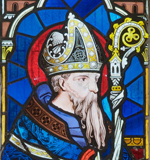 2019 Conferences
2019 Conferences
2019 proved to be a busy year for conferences, and in most cases I gave talks relevant to recent work on the imagery of saints in Wales.
The first was in May for the '‘King Arthur of Wales?’ conference in Carmarthen, followed by three in July. The ‘Vitae Sanctorum Cambriae’ project organised three sessions at the International Medieval Congress, Leeds, and several members of the project team, past and present, gave papers at the sixteenth International Congress of Celtic Studies (a quadrennial event, held at Bangor in 2019), at the end of the month. In between, I gave a paper on saints in stained glass commissioned for Catholic churches in nineteenth-century Wales at the 'Catholicism, Literature, and the Arts' conference in Durham.
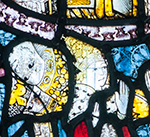 A conference in Cambridge organised by the ‘Vitae Sanctorum Cambriae’ project came at the end of September, at which I gave a paper on medieval images of saints in Wales, and also a short paper on some recent discoveries of images of Welsh saints found at churches in England. My final conference paper of the year, for the 'Art of the Lost' conference at Canterbury Cathedral in November, was on a different subject: the preservation of medieval fragments in the creation of abstract windows, and of the adoption of a similar aesthetic in new windows.
A conference in Cambridge organised by the ‘Vitae Sanctorum Cambriae’ project came at the end of September, at which I gave a paper on medieval images of saints in Wales, and also a short paper on some recent discoveries of images of Welsh saints found at churches in England. My final conference paper of the year, for the 'Art of the Lost' conference at Canterbury Cathedral in November, was on a different subject: the preservation of medieval fragments in the creation of abstract windows, and of the adoption of a similar aesthetic in new windows.
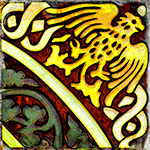 Teiliau Tyddewi/The Tiles of St Davids
Teiliau Tyddewi/The Tiles of St Davids
I made a special new piece of work for the 2019 Art on the Faith Trail, based on one of the tile patterns from the medieval pavement in the presbytery of St Davids Cathedral. A set of sixteen ‘tiles’ were distributed across all of the churches taking part in the trail in Pembrokeshire, including the cathedral itself. The whole piece was shown together with a new body of work, also based on the tiles at the cathedral, at an exhibition in the Cloister Gallery, St Davids Cathedral, 22 October – 4 November 2019. A book of the work was also published by Sulien Books to coincide with the exhibition.
Teiliau Tyddewi was also exhibited at Greenbelt Festival and the 2019 Diverse Manners exhibtion in Newport. It was due to return to St Davids for the 2020 Festival, which, like so many things in 2020, unfortunately had to be cancelled.
For more information about the project, visit the Teiliau Tyddewi/The Tiles of St Davids website. A book of the images is available from the Sulien Books website.
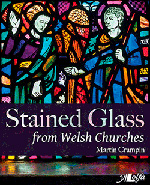 Stained Glass from Welsh Churches wins Mrs Foster Watson Memorial Gift
Stained Glass from Welsh Churches wins Mrs Foster Watson Memorial Gift
Four and a half years since Stained Glass from Welsh Churches was published, it was awarded the Mrs Foster Watson Memorial Gift, awarded every five years to a member of staff of Aberystwyth University for published work that combines scholarship with general interest.
The assessors commented: 'It is a substantial work of pioneering scholarship, spanning the centuries. At the same time it explains the development of this specialist art-form and craft in terms that the wider audience of cultured readers will understand. It thus fits perfectly the criteria set for the competition and fully deserves the award'.
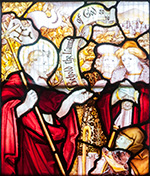 More than 7000 images of stained glass now on 'Stained Glass in Wales'
More than 7000 images of stained glass now on 'Stained Glass in Wales'
The 'Stained Glass in Wales' catalogue has been available online since 2011, having been developed as an offshoot of the 'Imaging the Bible in Wales' database of 2008.
I received two small grants in 2018 to make changes and additions to the catalogue from the Kempe Trust and the Glaziers Trust. The former enabled me to spend time adding work by C.E. Kempe and his studio, including work from churches in Barmouth, Carmarthen, Newbridge-on-Wye and Llangattock Vibon Avel. After some additional work adding stained glass at these churches by other makers, I checked the site statistics and noted that the total number of images of windows (including details) is now more than 7000. There are actually over 8500 images on the entire database, including non-stained glass material on the 'Imaging the Bible' site, and exterior views of churches shared by both sites.
The grant from the Glaziers Trust has allowed for the inclusion of CVMA numbering for windows in churches, thanks to the technical work of Nigel Callaghan. He has also been helping behind the scenes on some other small improvements. In addition, the Church in Wales kindly shared their list of churches in Wales, with associated grid references, links to their Church Heritage Cymru site and the Royal Commission's Coflein. I went through this list, preparing a long list of place-names and churches that were uploaded in bulk to the site, in the hope that future additions to the catalogue can be added a little more efficiently. I am grateful to the Church in Wales, who provided the funding for Nigel Callaghan to complete this work and facilitate links to Church Heritage Cymru.
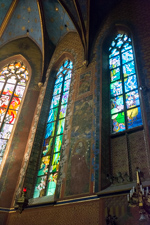 Stained Glass from c.1800 to 1945: Terminology – Periodization – Forms
Stained Glass from c.1800 to 1945: Terminology – Periodization – Forms
International Conference, Institute of Art History, Jagiellonian University, Kraków, 6–7 December 2017
This conference gathered together scholars from six European countries and the United States to discuss recent work on post-medieval glass in each of our countries. Several national committees of the Corpus Vitrearum Medii Aevi have decided to begin to systematically record the stained glass of their countries into the modern period, rather than just their medieval stained glass. The Polish CVMA have been among the pioneers of this initiative, and have published a fine series of volumes on the stained glass in the southern states of Poland.
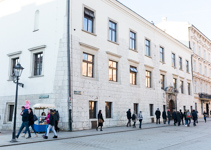 The conference programme included visits to two churches in the city, one of which brought us face to face with fourteenth-century glass on scaffolding high in the east end of St Mary's Basilica, a church adjoining the main square. But the focus of the conference was on more recent glass and seeing the extraordinary windows by Stanisław Wyspiański at the Franciscan Church was a particular highlight (above left). The striking modernism of these windows, made over a hundred years ago, is unlike anything that was being produced for churches in Britain at that date. The artist was also responsible for extensive mural decoration of the church as well.
The conference programme included visits to two churches in the city, one of which brought us face to face with fourteenth-century glass on scaffolding high in the east end of St Mary's Basilica, a church adjoining the main square. But the focus of the conference was on more recent glass and seeing the extraordinary windows by Stanisław Wyspiański at the Franciscan Church was a particular highlight (above left). The striking modernism of these windows, made over a hundred years ago, is unlike anything that was being produced for churches in Britain at that date. The artist was also responsible for extensive mural decoration of the church as well.
For further information about the conference, see the review by Jasmine Allen.
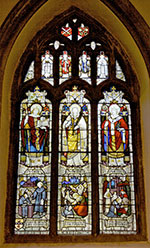 The Saints of Llandaff
The Saints of Llandaff
The first of a series of events related to the 'Vitae Sanctorum Cambriae' (The Latin Lives of the Welsh Saints) project took place at Llandaff Cathedral on 11 November. The afternoon event continued a series of events that I organised for the proceeding ‘Cult of Saints in Wales’ project in 2015 and 2016, with members of the project team and other experts sharing recent work on saints in Wales.
Most of the talks were held in Prebendal House, adjacent to the cathedral, but I took the opportunity to speak about the two windows in the Dyfrig Chapel that depict saints and legendary kings in Wales, one of which was commissioned by Sir William Thomas Lewis, first baron Merthyr, while the second was placed there in his memory.
While the saints that became patrons of the new cathedral in the twelfth century were Dyfrig, Teilo and Euddogwy, Lewis chose Tudful and Elfan to be the main figures in the window (with Teilo), while saints associated with the Lucius legend were included in the tracery lights.
Pembrokeshire, June–July 2017
I recently participated in the 'Art on the Faith Trail' initiative in June and July. Artists exhibited their work in a number of churches in northern Pembrokeshire, as well as at St Davids Cathedral. Examples of my work were shown at Llanwnda, Llanychaer and Pontfaen, churches that are all within a few miles of Fishguard, and three pieces were included in the display at St Davids Cathedral.
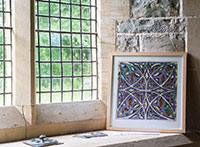 All of the work was based on various examples of medieval decorative arts found in churches across Wales, so the opportunity to show some of the pieces in church settings seemed particularly appropriate. I was also pleased to hear that in some cases services had made liturgical use of some of the pieces.
All of the work was based on various examples of medieval decorative arts found in churches across Wales, so the opportunity to show some of the pieces in church settings seemed particularly appropriate. I was also pleased to hear that in some cases services had made liturgical use of some of the pieces.
 The Middle Ages in the Modern World Conference
The Middle Ages in the Modern World Conference
University of Manchester 28 June – 1 July 2017
I was invited to join a panel on medievalism in Wales at 'The Middle Ages in the Modern World' Conference, Manchester, presenting my research on medievalism and Celticism in the visual arts of Wales during the twentieth century.
In addition to my talk I also exhibited some of my prints based on the medieval tiles at Strata Florida and the rood screen at Llananno. I was also asked if I could help out with providing an image for the conference bag, and came up with the image shown here. The image tried to echo the many papers analysing the representation of the Middle Ages, in its many guises, in contemporary film, television and games.
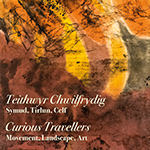 On the Move: Curious Travellers come to Oriel Brondanw and Old College Aberystwyth
On the Move: Curious Travellers come to Oriel Brondanw and Old College Aberystwyth
In autumn 2016 I took part in an innovative group exhibition at Oriel Sycharth, Wrexham, in which thirteen artists responded to Thomas Pennant’s Tours in Wales. The exhibition was organised as a contribution to the 'Curious Travellers' research project by my colleagues at the Centre for Advanced Welsh and Celtic Studies, Mary-Ann Constantine and Elizabeth Edwards. My work for the exhibition was based on the rood screen and architectural sculpture at the Church of All Saints, Gresford, a church that Thomas Pennant visited and wrote about.
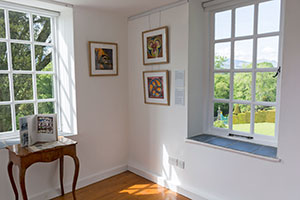 The show was installed at the magical location of Oriel Brondanw, near Llanfrothen, and ran until 25 June 2017. The architecture, gardens and views at Brondanw are exquisite and provided a fine setting for the work. It then moved to Old College, Aberystwyth, in July, but was in an abridged form, in a smaller space.
The show was installed at the magical location of Oriel Brondanw, near Llanfrothen, and ran until 25 June 2017. The architecture, gardens and views at Brondanw are exquisite and provided a fine setting for the work. It then moved to Old College, Aberystwyth, in July, but was in an abridged form, in a smaller space.
Four of the exhibiting artists gave short talks about their work on Tuesday 25 July, at Old College, in which I participated.
A book of the exhibition was also published, which I designed and also provided much of the photography. It includes a double-page spread for each of the artists, an introduction, and poems by Ifor ap Glyn and Philip Gross. The book is available from the Centre for Advanced Welsh and Celtic Studies, or contact me for copies (priced £5).
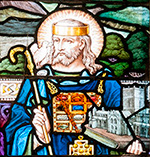 Saints and Stained Glass: talks in spring 2017
Saints and Stained Glass: talks in spring 2017
I gave a number of different kinds of talks and presentations during the second quarter of 2017.
On 1 April, I contributed to an afternoon of talks at the Church of St Padarn, Llanbadarn Fawr: 'Padarn and the Saints of Wales'. During the preceding week, my colleague David Parsons and I gave gallery talks for the 'Stories of the Saints' exhibition at the National Library of Wales on 29 March. I was also interviewed about the exhibition for 'Sunday Matters', which was broadcast across Radio Pembrokeshire, Radio Carmarthenshire and Radio Ceredigion on Sunday 26 March.
I helped to lead visits for the Stained Glass Museum Study Weekend to a number of churches in north-east Wales (21–23 April), together with Jasmine Allen, curator of the Stained Glass Museum, and Penny Hebgin-Barnes, an expert on medieval stained glass. The weekend brought me back to many churches that I had visited before, but also introduced me to some new places in Cheshire, in particular the private chapels at Cholmondeley Castle and Eaton Hall.
In May I was invited to speak about medievalism in nineteenth-century stained glass at the 'Reframing Stained Glass' conference in Cambridge, organised by Gareth Atkins of the 'Bible and Antiquity Project', Centre for Research in the Arts, Social Sciences and Humanities (CRASSH).
I returned to a mix of saints and stained glass for two talks at the National Library of Wales. I gave a lunchtime lecture about the imagery of saints in churches in Wales on 17 May and on 3 June I was among the speakers at a one-day conference 'Stories of the Saints'.
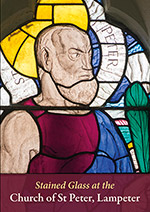 New book on the stained glass at Lampeter available: March 2017
New book on the stained glass at Lampeter available: March 2017
I collaborated with John Hammond on a new book about the stained glass at the Church of St Peter, Lampeter. The book was published by my imprint, Sulien Books.
The cover of the book features the image of Peter from the impressive west window by Wilhelmina Geddes, and is among her best works. This window is one of many stained glass windows at the church, which includes work by a number of nineteenth and twentieth century makers, such as Bell & Almond, Lavers & Barraud, Robert Newbery, Ninian Comper and Powell & Sons.
Copies of the book can be obtained from the church and are available from the Sulien Books website. A launch event was held in July.
Exhibition at the National Library of Wales 18 February – 10 June 2017
I co-curated an exhibition of medieval and early modern manuscripts at the National Library of Wales, as part of my work on 'The Cult of Saints in Wales' project.
In 2017, the Year of Legends, the exhibition remembers the stories of the saints that were once plentiful in medieval Wales, although many are forgotten today. The lives of these early saints, their genealogies, and poetry addressed to them, are preserved in manuscripts that are being exhibited at the National Library of Wales. This exhibition demonstrates the survival of medieval traditions about the holy men and women who represent an important part of Welsh cultural inheritance.
In addition to the manuscripts, there are other items from the National Library collection on display, and photographs of surviving medieval images of saints from my photographic archive. As well as co-writing some of the material with my colleague David Parsons, I also designed all of the interpretative material.
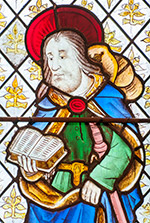 Vitae Sanctorum Cambriae: The Latin Lives of the Welsh Saints
Vitae Sanctorum Cambriae: The Latin Lives of the Welsh Saints
Following the success of a recent funding application to the Arts and Humanities Research Council, my current project at the Centre for Advanced Welsh and Celtic Studies, 'The Cult of Saints in Wales', will be succeeded by a new project that begins in January 2017.
This new project is based at the University of Cambridge and will be run in collaboration with the Centre, led by Professor Paul Russell. The project continues the work of editing and translating medieval texts about saints in Wales, but turns our attention from Welsh-language texts to Latin ones.
The projects overlap for a few months, as the 'Cult of Saints in Wales' officially concludes in March. We are presently completing the interpretation for the forthcoming exhibition 'Chwedlau'r Seintiau' / 'Stories of the Saints' at the National Library of Wales, which opens in February.
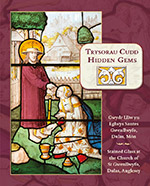 Stained glass at Llanwenllwyfo
Stained glass at Llanwenllwyfo
A new book about the sixteenth- and seventeenth-century stained glass at Llanwenllwyfo, in northern Anglesey, was published by Sulien Books in November 2016.
The text is primarily the work of the late J.O. Hughes and his wife Catherine Hughes, and their notes were prepared by Avril Lloyd for publication, who also oversaw the translation for a parallel Welsh text. The book provides an introduction to the church and its patrons, which also explains how the stained glass was acquired by the family. There are illustrations and notes for all of the main panels.
In addition, I added a section about the dating and attribution of the glass, which has been a subject of debate for the last thirty-five years or more. I also contributed an article about the sixteenth-century glass for the November issue (104) of Vidimus. Copies of the book, with parallel English and Welsh texts, can be obtained from the church or from the Sulien Books website.
 Lectures for November 2016
Lectures for November 2016
I have recently given lectures on stained glass in Shrewsbury and in Bangor. The lecture on 17 November at Shrewsbury Museum and Art Gallery introduced David Evans and the early Gothic Revival in the first half of the nineteenth century. This was part of the accompanying programme of events organised by the Friends of the Museum and Art Gallery to coincide with the Margaret Rope exhibition. David Evans was also relevant to the talk in Bangor for the North West Wales Art Fund at Storiel, Bangor, on the 22 November 2016. He made the figures for the east window of Bangor Cathedral in 1840 and 1843 (see my blog post about this commission), and the talk provided an introduction to the stained glass in the churches of Bangor, including those recently closed.
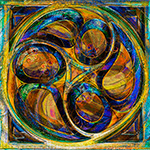
Curious Travellers: Movement, Landscape, Art
Oriel Sycharth, Wrexham: 10 October – 16 December 2016
Resurgence: Diverse Manners Arts Group
Riverfront Art Gallery: 3 – 29 October 2016
This autumn I have participated in two group exhibitions, which opened in October. Both shows include new work based on the rood screen at the Church of All Saints, Gresford. I also spoke about the church at an event at Oriel Sycharth, with the poet Philip Gross, on 22 October, organised as part of the Curious Travellers project. The project is researching Romantic-period accounts of journeys into Wales, and I have also been contributing occasional posts for the Curious Travellers website.
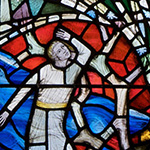
Sheffield
8 September 2016
I participated in this year's History and Heritage section of the SGT Centenerary conference.
The paper considered the ways in which some of the most influential modernist stained glass artists have been influenced by medieval stained glass and sculpture. The medievalism of Victorian Gothic Revival stained glass has been well appreciated, but a continuing fascination with stained glass of an earlier medieval period by artists such as John Piper, Lawrence Lee and Wilhelmina Geddes has created competing medievalisms that have coloured our appreciation of much nineteenth- and early twentieth-century stained glass.
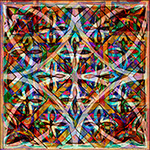
Scene/Unseen Exhibition
Allotment Gallery, Greenbelt Festival
29 August 2016
I brought a small selection of work to the festival for a temporary show, which included images based on the panels from the screen at Llananno as well as photographs of stained glass windows from churches in Wales.
